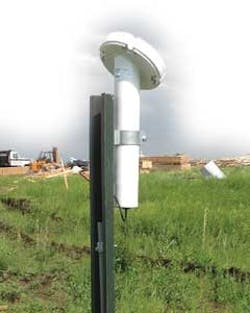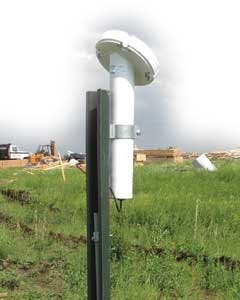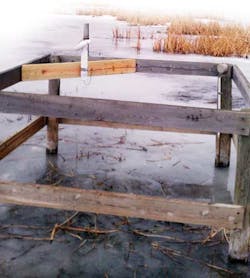Satellite Meter Reading Provides Smart Water Management for Remote Areas
By Anu Sood
In early 2011, West River/Lyman-Jones Rural Water Systems (WR/LJ) was living with the painful reality experienced by many rural water utilities. With a service area of over 8,000 square miles and only eight full-time employees, collecting meter readings came with a high level of frustration and excessive cost for the South Dakota co-op.
Because of its low customer density in a large service area, the co-op maintained a self-read and self-bill meter system where customers were required to call and mail in their meter reading every month. "Members would go weeks without reading," said Jake Fitzgerald, General Manager of WR/LJ. "We wouldn't know of any discrepancies until we completed an annual meter audit where we would identify huge water losses on the customer side. The customer would go into bill shock seeing thousands of dollars for unpaid water usage, and collecting on those bills caused heartburn for everyone."
The co-op determined it needed a solution that allowed them to gather daily readings without relying on their customers.
New Meter Reading Solution
In late 2011, WR/LJ began looking for an automatic meter reading (AMR) solution that would work uniformly across its entire customer base, regardless of the type of meter onsite or the available communication infrastructure for relaying meter readings.
The co-op was also hoping that a new system would solve another ongoing problem. "We would notice high flows using our master meters," recounted Fitzgerald. "But if we couldn't find a leak on our line, we were out chasing meters, physically driving out to these remote locations to see how many gallons per minute customers were using at every location. It was slow and expensive for us and for our members."
The co-op, after much research and consideration, opted for the satellite water meter reading system offered by IDT to solve its ongoing data issues and meet its leak-detection objectives. The IDT Harmony Water Management System is a two-part solution consisting of the Harmony satellite field units and the Harmony cloud web application. The Harmony satellite field unit connects with most major water meters and is responsible for sending daily meter reading data to the Harmony cloud web application via satellite. Battery life on the satellite field units is guaranteed for 3,650 reads, or 10 years of daily readings.
Since the readings are relayed using SkyWave satellite messaging terminals, there is no requirement to install fixed radio towers or clustered repeaters, which can be a financial challenge for most low-density, topographically-challenged rural water utilities. The use of satellite also removes the requirements associated with maintaining communication infrastructure.
The Harmony cloud web application is a web-based interface that aggregates the data from all water meters. It allows utility managers to closely analyze and monitor water consumption and receive alerts if unusually high consumption is detected. The system also allows the utility to bill customers for their consumption.
Results That Make a Difference
Soon after the initial installation of satellite meter reading systems across the region, WR/LJ made some startling discoveries. "Within the first few months, the new satellite meter reading system helped us detect over 30 leaks on the customers' side of the meter," said Fitzgerald. "That number of detected leaks surprised us because we were hoping to detect that many in a year."
In all of the cases, individual service meters set off an alarm that notified the office and field staff of a spike in usage. The flows (leaks) ranged from 4,000 up to 42,000 gallons per day. One leak involved a board member of the water co-op who was losing 13 gallons per minute.
"Not only were the customers very appreciative of these calls, but narrowing our water loss to that level is something we could never do before. It is now part of our mornings to call customers whose meters have alarmed," explained Fitzgerald. "Our customers are always happy when we call, and they know we're saving them water when we call them. They really appreciate that."
Satellite Meter Reading for 100 Percent Coverage
Thinking back on his options, Fitzgerald recounted some of the considerations that he worked through with DGR Engineering, the firm he worked with before the co-op ultimately opted for a satellite meter reading system. "A lot of our customers' meters are within river breaks, and so we knew that with a drive-by meter reading system we would have to drive a lot of miles to get close enough for a meter reading every month. The operating costs were too high," said Fitzgerald.
According to DGR Engineering's John Madden, fixed radio systems with towers and repeaters also did not meet the metering demand for WR/LJ. "In a cost-versus-benefits study, we found the infrastructure would cost millions of dollars for a system that would only read about half of the meters," explained Madden.
Installing Satellite Meter Reading Systems
Besides communication coverage, ease of installation was another consideration for WR/LJ. Carstensen Contracting was able to install two-thirds of the meter reading systems in a four-month period. "It used to take us three months just to complete an annual meter reading audit and another year to have reliable data," said Fitzgerald. "Having everything done in four months completely changed the way we do things."
Looking Ahead
"The board and I are happy with [this] solution. Most importantly, the membership is pleased with the system," said Fitzgerald. "If a system works in our service area with all the river breaks and badlands, it's going to work anywhere."
In addition to continuing to upgrade customer meters with satellite meter reading systems, WR/LJ is considering IDT's Harmony Valve system, which allows utilities to remotely switch customers' water off and on or control other functions.
"[It] has the potential to further reduce our operating costs," said Fitzgerald. "Keeping our costs down means keeping water rates down for our customers."
About the Author: Anu Sood is the Global Channel Marketing Manager at SkyWave Mobile Communications where she is focused on machine-to-machine (M2M) services and solutions for the transportation, oil & gas and utilities markets.


